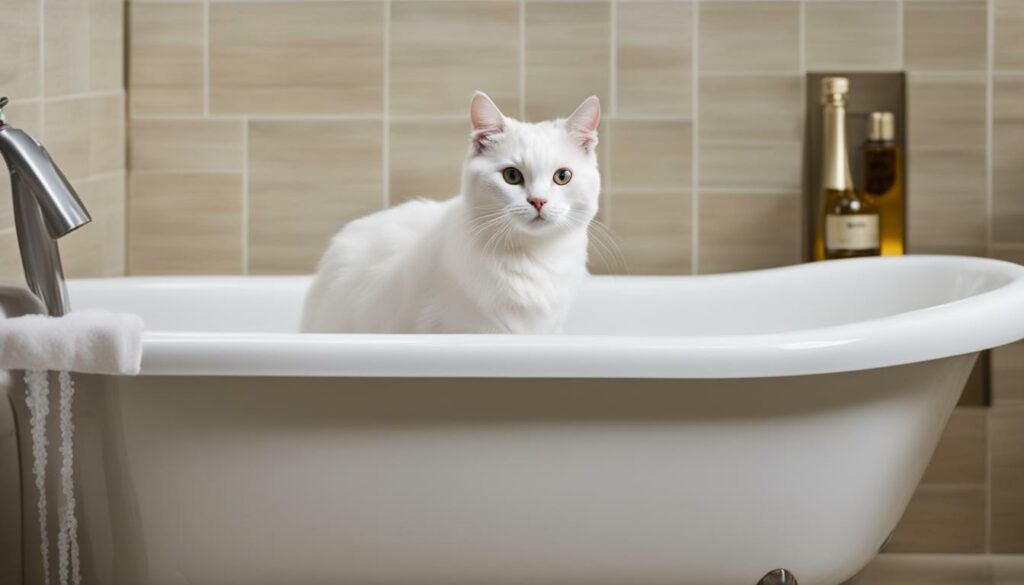I have always been passionate about pet care, especially when it comes to addressing common dermatological issues that our feline friends may face. Today, I want to explore a topic that affects many cats: dandruff. Just like us humans, cats can experience dandruff, which can cause discomfort and impact their overall well-being. In this article, we will delve into key aspects of dandruff in cats, including its causes, symptoms, and effective solutions.
When it comes to cat dandruff, it’s important to understand that it can occur on their entire body, not just their scalp. There are various factors that can contribute to cat dandruff, such as dry indoor air, chronic illnesses, and poor grooming habits. It’s crucial to differentiate between cat dander and cat dandruff, as they have different symptoms and causes. If your cat shows additional symptoms or if the dandruff is sudden and severe, it is recommended to visit a veterinarian to rule out any underlying disorders.
Managing and preventing cat dandruff is possible through regular grooming, adjusting the environment, and maintaining a healthy diet and hydration for your cat. By taking these steps, you can help improve the health of your cat’s skin, reduce dandruff, and ensure their overall comfort.
Key Takeaways:
- Dandruff in cats can occur on their entire body, not just their scalp.
- Understanding the difference between cat dander and cat dandruff is crucial.
- Visit a veterinarian if your cat shows additional symptoms or if the dandruff is sudden and severe.
- Regular grooming, adjusting the environment, and maintaining a healthy diet and hydration can help manage and prevent cat dandruff.
- By taking these steps, you can improve your cat’s skin health and overall well-being.
Cat Dandruff Symptoms
Cat dandruff can manifest through various symptoms, indicating potential skin issues in our feline friends. One of the most common signs is red, dry, flaky, and itchy skin. These symptoms can appear on different parts of the cat’s body, including the face, back, tail, and other areas. It is essential to pay attention to these signs as they can cause discomfort and irritation to your cat.
If you notice excessive scaling, redness, or any unpleasant odor accompanied by dandruff, it is advisable to consult a veterinarian. They can provide a proper diagnosis and rule out any underlying conditions that may be causing the dandruff. Remember, cat dandruff is usually not a serious condition, but it’s always best to seek professional advice to ensure your cat’s well-being.
Cat Dandruff Symptoms:
- Red, dry, flaky skin
- Itchiness
- Discomfort
- Possible odor
“It is essential to pay attention to these signs as they can cause discomfort and irritation to your cat.”
By recognizing the symptoms of cat dandruff, you can take proactive steps to manage and alleviate the discomfort experienced by your furry companion. This may involve adjusting their grooming routine, providing proper nutrition, and addressing any underlying health issues that may be contributing to the dandruff.
| Symptom | Description |
|---|---|
| Red, dry, flaky skin | Visible signs of irritation on the cat’s skin, often accompanied by itchiness |
| Itchiness | Constant scratching or biting at the affected areas |
| Discomfort | Signs of distress or restlessness due to the irritation caused by dandruff |
| Possible odor | Unpleasant smell emanating from the affected areas of the cat’s skin |
What Causes Dandruff in Cats?
Dandruff in cats can be caused by various factors, including inadequate grooming, poor nutrition, and underlying health issues. Cats that do not receive regular grooming may experience an accumulation of dead skin cells and oils on their fur, leading to dandruff. Additionally, cats with poor nutrition may lack the essential vitamins and minerals necessary for healthy skin, which can contribute to the development of dandruff. Underlying health issues such as contact dermatitis, diabetes, hyperthyroidism, fungal infections, parasites, seborrhea, and food allergies can also trigger dandruff in cats.
Understanding the specific cause of dandruff in your cat is important in order to effectively manage and treat the condition. Inadequate grooming can be addressed by implementing regular brushing and bathing routines for your cat. Providing a balanced and nutritious diet that meets your cat’s specific dietary requirements can help improve the health of their skin. If an underlying health issue is suspected, it is recommended to consult with a veterinarian for proper diagnosis and treatment.
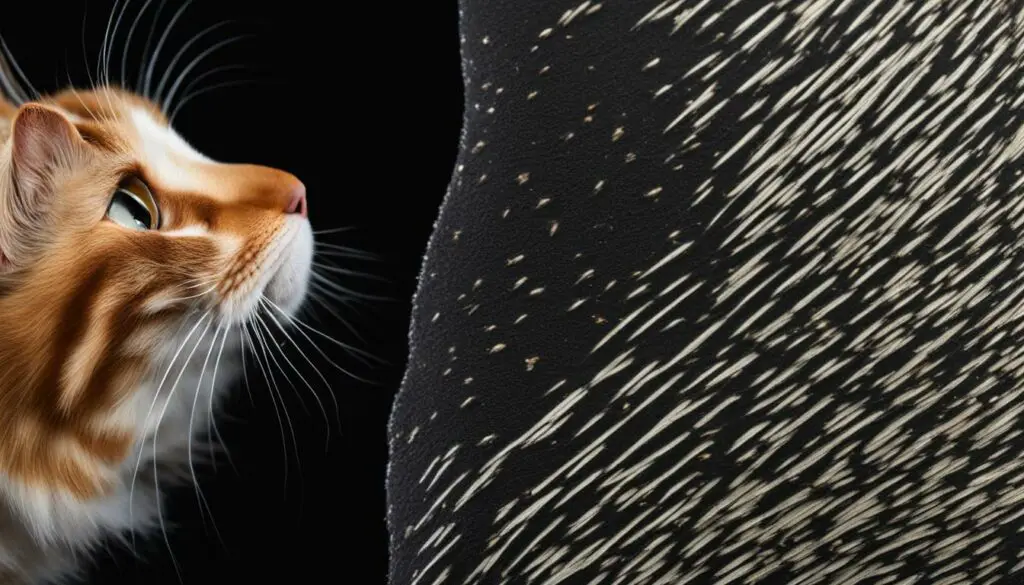
When to Visit Your Veterinarian
If your cat is experiencing dandruff along with any of the following symptoms, it is essential to schedule a visit to your veterinarian:
- Appetite changes: If your cat is showing a sudden decrease or increase in appetite, it could indicate an underlying health issue.
- Excessive itching or grooming: Persistent scratching and grooming could be a sign of skin irritation or allergies.
- Excessive thirst: Increased water intake may be a symptom of certain diseases, such as diabetes or kidney problems.
- Lethargy: If your cat is unusually tired or lacks energy, it could signal an underlying health problem.
- Litter box issues: Changes in litter box habits, such as frequent urination or difficulty in urinating, may indicate urinary tract issues.
- Skin lesions: If you notice open sores, rashes, or other abnormalities on your cat’s skin, it could be a sign of infection or skin disease.
- Visible parasites: Fleas, ticks, or other external parasites can cause skin irritation and discomfort for your cat.
- Vomiting: Frequent or persistent vomiting could be a sign of gastrointestinal problems or other medical conditions.
These symptoms, when combined with dandruff, may indicate an underlying disorder or health issue that requires diagnosis and treatment from a veterinarian. It’s important to seek professional veterinary care to ensure the well-being of your feline companion.
Remember, as a responsible pet owner, it is essential to monitor your cat’s overall health and behavior. Regular check-ups with your veterinarian can help detect any potential health problems early on and provide the necessary care and treatment.
| Symptom | Possible Causes |
|---|---|
| Appetite changes | Underlying health issues |
| Excessive itching or grooming | Skin irritation or allergies |
| Excessive thirst | Diabetes, kidney problems |
| Lethargy | Underlying health problems |
| Litter box issues | Urinary tract issues |
| Skin lesions | Infection, skin disease |
| Visible parasites | Fleas, ticks, external parasites |
| Vomiting | Gastrointestinal problems |
Cat Dandruff Solutions
Managing cat dandruff requires a combination of approaches to address both the symptoms and underlying causes. Here are some solutions that can help:
- Adjust the environment: Maintaining an optimal humidity level in your home can help prevent dry skin. Consider using a humidifier to add moisture to the air, especially during dry winter months.
- Manage underlying conditions: If your cat’s dandruff is caused by an underlying health issue, such as allergies or hormonal imbalances, it’s important to work with your veterinarian to manage the condition effectively. This may involve medication or dietary changes.
- Bathing and brushing: Regular grooming is essential for managing dandruff. Bathing your cat with a cat-safe shampoo can help remove excess oil and flakes from their skin. Be sure to use a gentle, moisturizing shampoo specifically formulated for cats. Regular brushing helps distribute natural oils and remove dead skin cells.
- Dietary changes: A healthy diet is crucial for maintaining your cat’s skin health. Consider switching to a high-quality cat food that contains essential fatty acids, such as omega-3 fatty acids, which promote healthy skin and coat. Consult with your veterinarian for recommendations specific to your cat’s needs.
- Moisturizing: Applying a moisturizer specifically formulated for cats can help alleviate dryness and flakiness. Look for products that contain ingredients like aloe vera or oatmeal, which have soothing properties for the skin.
- Use a humidifier: Adding moisture to the air can help prevent dry skin. Consider using a humidifier in your home, especially in rooms where your cat spends a lot of time.
Remember, managing cat dandruff requires consistency and patience. It may take some time to find the combination of solutions that works best for your cat. If your cat’s dandruff persists or worsens despite your efforts, it’s important to consult with your veterinarian for a thorough evaluation and further guidance.
| Solution | Description |
|---|---|
| Adjust the environment | Use a humidifier to add moisture to the air and maintain an optimal humidity level in your home. |
| Manage underlying conditions | Work with your veterinarian to identify and manage any underlying health issues that may be contributing to your cat’s dandruff. |
| Bathing and brushing | Regularly bathe your cat with a cat-safe shampoo and brush their coat to remove excess oil and flakes. |
| Dietary changes | Switch to a high-quality cat food that contains essential fatty acids to promote healthy skin and coat. |
| Moisturizing | Apply a moisturizer specifically formulated for cats to alleviate dryness and flakiness. |
| Use a humidifier | Add moisture to the air by using a humidifier, especially in rooms where your cat spends a lot of time. |
“Managing cat dandruff requires consistency and patience. It may take some time to find the combination of solutions that works best for your cat.”
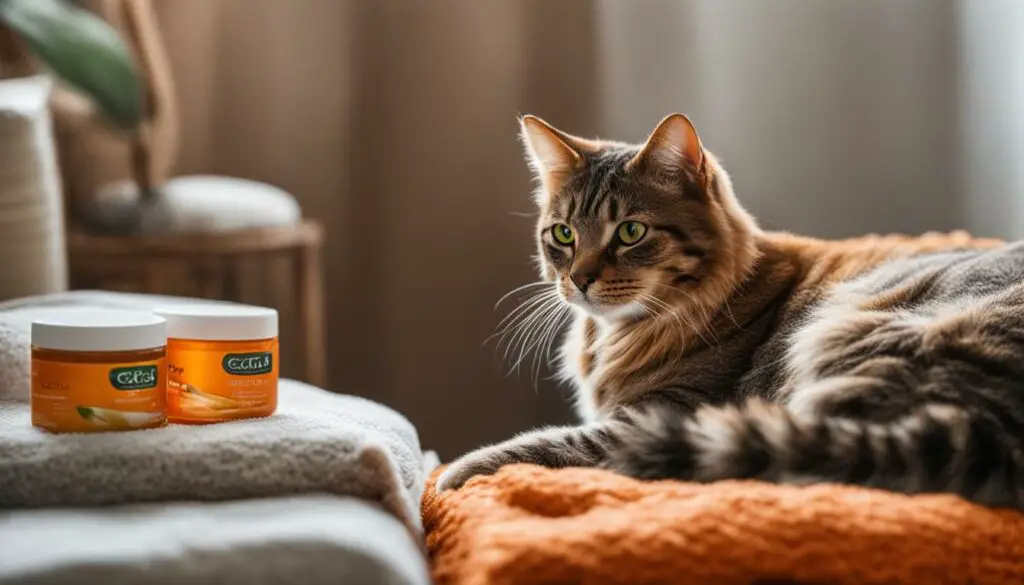
Skin Care for Cats
When it comes to maintaining the health of your cat’s skin, regular brushing plays a crucial role. Not only does it help keep their coat neat and tangle-free, but it also distributes natural oils that are essential for a healthy skin and coat. Regular brushing stimulates the cat’s circulatory system, promoting better blood flow and overall skin health.
By brushing your cat regularly, you can remove dead skin cells and loose fur, preventing them from becoming trapped and causing irritation. Additionally, it helps to improve the appearance and shine of their coat, leaving them looking and feeling their best.
“Regular brushing is not only a grooming routine, but it is also an opportunity for bonding with your feline friend. It allows you to spend quality time together while keeping their skin and coat in optimal condition,” says Dr. Sarah Johnson, a veterinarian with expertise in feline care.
Important Tips for Brushing:
- Choose a brush that is suitable for your cat’s coat type. For example, a slicker brush is ideal for long-haired cats, while a rubber brush or grooming glove works well for short-haired breeds.
- Start brushing your cat from a young age to get them accustomed to the process.
- Brush gently and gradually increase the duration of each session as your cat becomes more comfortable.
- Pay extra attention to areas that are prone to matting, such as behind the ears and under the armpits.
- If your cat has sensitive skin or is prone to tangles, consider using a detangling spray or conditioner to make brushing easier.
Remember, regular brushing is not only beneficial for your cat’s skin, but it also strengthens the bond between you and your feline companion. Make it a part of your grooming routine to ensure their skin remains healthy and their coat stays beautiful.
| Benefits of Regular Brushing for Cats |
|---|
| Helps distribute natural oils, keeping the coat supple and shiny |
| Prevents matting and tangling of fur |
| Stimulates the circulatory system for better skin health |
| Reduces hairballs by removing excess fur |
| Strengthens the bond between cat and owner |
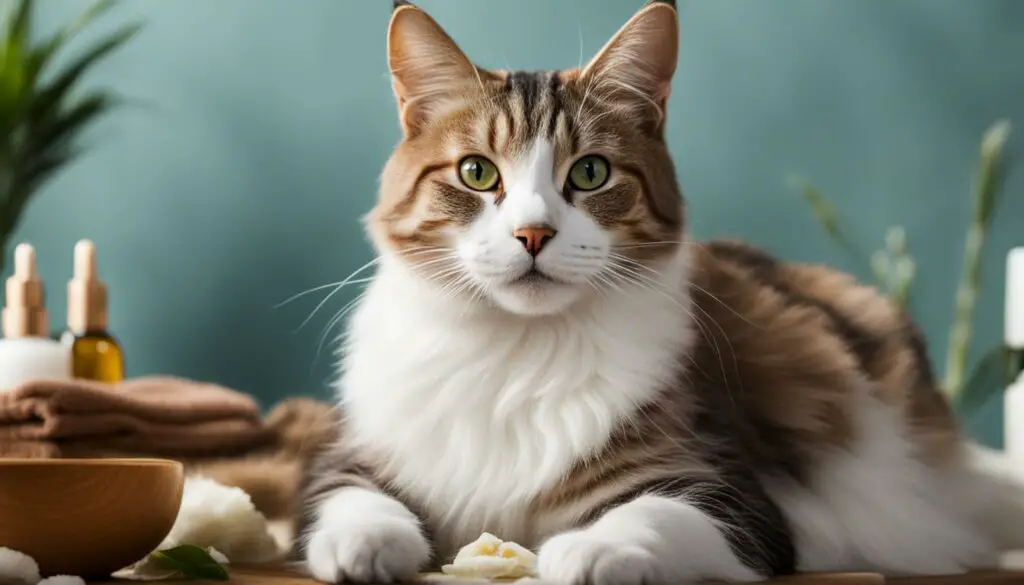
Common Skin Care Mistakes to Avoid:
- Overbrushing: While regular brushing is important, excessive brushing can irritate your cat’s skin. Avoid brushing too vigorously or for extended periods of time.
- Using the wrong type of brush: Different cat breeds have different coat types, so it’s crucial to choose a brush that suits your cat’s specific needs. Research the appropriate brush for your cat’s coat to avoid causing discomfort or damage.
- Ignoring skin abnormalities: Regular brushing also allows you to check your cat’s skin for any abnormalities such as redness, sores, or lumps. If you notice anything unusual, consult your veterinarian for proper diagnosis and treatment.
Grooming
Grooming is an essential part of managing cat dandruff. Regular grooming helps to remove dead skin cells and distribute natural oils across the cat’s coat, promoting a healthier skin and reducing dandruff. Here are some grooming practices that can help in managing cat dandruff:
- Bathing: While cats are known for their self-grooming abilities, occasional baths can be beneficial. Use a cat-safe shampoo and follow proper bathing techniques to avoid stressing out your cat.
- Additional Brushings: Increase the frequency of brushing to remove loose fur and stimulate the skin. Use a brush suitable for your cat’s coat type to effectively remove dandruff.
- Self-Grooming Products: Consider using self-grooming products such as grooming gloves or brushes that cats can use on their own. These products help to remove loose hair and dandruff while simulating the sensation of being groomed by another cat.
- Wipes: Wipes formulated specifically for cats can be used for quick touch-ups in between baths. They help to remove dirt, dander, and excess oils from the cat’s coat. Choose wipes that are safe for cats and avoid using products meant for humans.
- Waterless Shampoos: Waterless shampoos are an alternative to traditional bathing. These shampoos come in spray or powder form and can be applied directly to the cat’s coat. They help to freshen up the cat’s fur and remove excess oil and dandruff.
By incorporating these grooming practices into your cat’s routine, you can effectively manage dandruff and maintain a healthy coat and skin. However, it’s important to note that if your cat’s dandruff persists or worsens, it is advisable to consult a veterinarian for further evaluation and treatment.
| Grooming Practice | Benefits |
|---|---|
| Bathing | Removes dirt and excess oils |
| Additional Brushings | Stimulates skin and removes loose fur and dandruff |
| Self-Grooming Products | Allows cats to groom themselves and remove dandruff |
| Wipes | Quick and convenient way to remove dander and oils |
| Waterless Shampoos | Freshens up fur and removes excess oil and dandruff |
Remember to approach grooming sessions with patience and a calm demeanor to ensure a positive experience for both you and your cat. Regular grooming not only helps in managing dandruff but also strengthens the bond between you and your feline companion.
Improving the Environment for Your Cat
Creating a comfortable environment for your cat is essential in managing and preventing dandruff. By making a few adjustments, you can help alleviate dry indoor air and manage allergens, leading to healthier skin for your feline friend. Here are some strategies to improve the environment for your cat:
Adding a Humidifier
Dry indoor air can contribute to dry skin and dandruff in cats. By adding a humidifier to your home, you can increase the moisture in the air, providing relief for your cat’s skin. Opt for a humidifier that is safe for pets and follow the manufacturer’s instructions for proper use. Maintaining an optimal humidity level can help prevent dryness and promote healthier skin.
Using Air Purifiers
Allergens in the air can trigger skin irritation and worsen dandruff in cats. Using air purifiers can help filter out these allergens, creating a cleaner and more comfortable environment for your cat. Look for air purifiers with HEPA filters, as they are designed to capture even the smallest particles, including pet dander and dust mites. Place the air purifier in a central location in your home for optimal air filtration.
Managing Allergens
If your cat has allergies, it’s important to identify and manage the allergens that may be causing their dandruff. Common allergens for cats include pollen, dust mites, and certain foods. Take steps to minimize exposure to these allergens, such as keeping windows closed during peak pollen seasons, regularly washing bedding in hot water, and providing a hypoallergenic diet if recommended by your veterinarian. Managing allergens can help reduce dandruff and improve your cat’s overall well-being.
Preventing Dry Indoor Air
Aside from using a humidifier, there are other measures you can take to prevent dry indoor air. Make sure your home is properly insulated to retain moisture and prevent drafts. Avoid using heating sources that dry out the air, such as wood-burning stoves or space heaters. If your home tends to be dry, consider placing bowls of water near heat sources to increase humidity. Creating a moist environment can help keep your cat’s skin hydrated and minimize dandruff.
By improving the environment for your cat, you can help manage and prevent dandruff, leading to healthier and happier feline companions. Adding a humidifier, using air purifiers, managing allergens, and preventing dry indoor air are simple yet effective strategies that can make a big difference in your cat’s skin health.
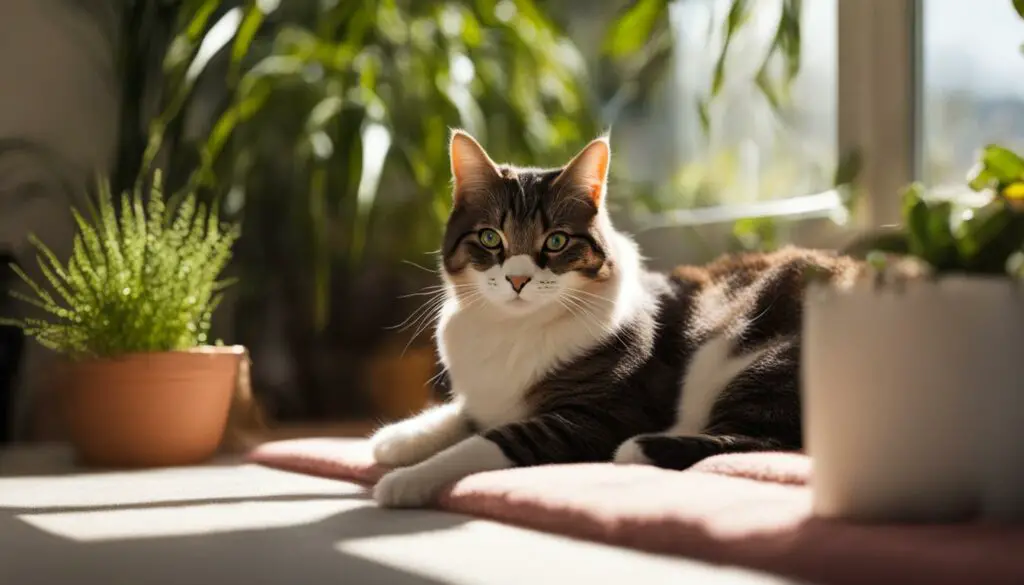
Cat Health, Diet, and Hydration
In order to effectively manage dandruff in cats, it is crucial to prioritize their overall health, diet, and hydration. Ensuring that your cat receives the necessary vitamins and minerals is essential for maintaining healthy skin. Consider incorporating skin-healthy nutrients into their diet, such as omega-3 fatty acids, which can help combat dryness and inflammation. Additionally, choosing cat food with a high moisture content can contribute to their overall hydration, promoting healthier skin and coat.
A well-balanced diet plays a significant role in managing dandruff in cats. Look for cat food that contains essential skin-healthy vitamins and minerals, such as vitamin E, vitamin A, and zinc. These nutrients can help support the health of your cat’s skin and reduce the occurrence of dandruff. It is always recommended to consult with a veterinarian for specific dietary recommendations tailored to your cat’s individual needs.
In addition to a proper diet, maintaining hydration is crucial for managing dandruff. Cats naturally have a low thirst drive, so it’s important to encourage them to drink enough water. Consider providing fresh water in multiple locations throughout your home and using a water fountain, as some cats prefer running water. You can also incorporate wet food into their diet, which can contribute to their overall hydration.
Benefits of Cat Wellness Plans
A cat wellness plan can be a valuable tool in ensuring your cat’s overall health and preventing dandruff. These plans often include regular check-ups with a veterinarian, vaccinations, dental care, and preventive treatments for parasites. By following a wellness plan, you can stay updated on your cat’s health and catch any potential issues early on. Additionally, your veterinarian can provide specific guidance and recommendations for managing dandruff and maintaining your cat’s skin health.
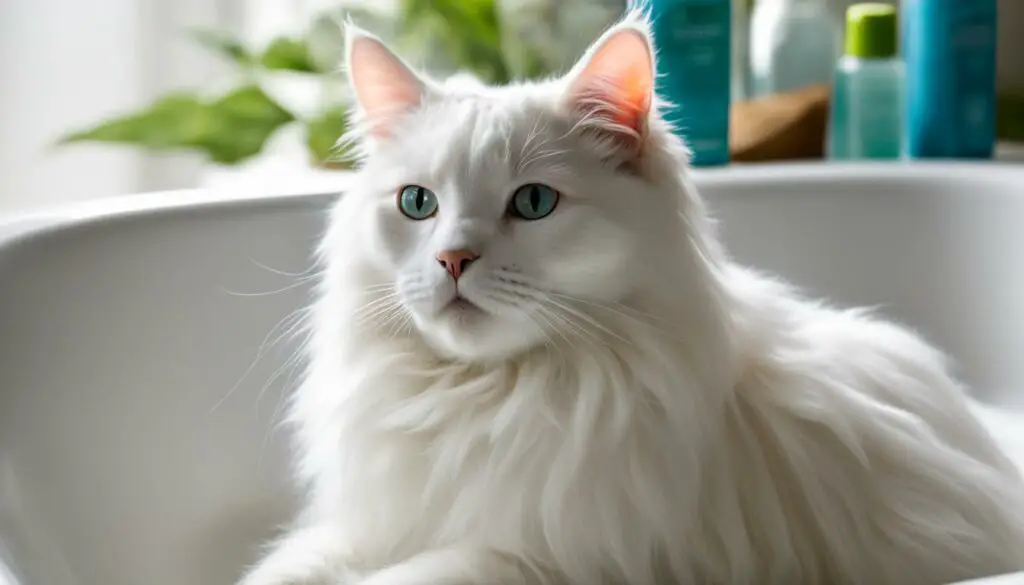
| Key Points for Cat Health, Diet, and Hydration |
|---|
| • Prioritize overall health, diet, and hydration to manage dandruff in cats. |
| • Incorporate skin-healthy vitamins and minerals into their diet. |
| • Choose cat food with a high moisture content to promote hydration. |
| • Consult with a veterinarian for specific dietary recommendations. |
| • Encourage your cat to drink enough water and consider a water fountain. |
| • Incorporate wet food into their diet to increase hydration. |
| • Consider a cat wellness plan for regular check-ups and preventive care. |
Don’t Let Dandruff Get Your Cat Down
When it comes to managing dandruff in cats, prevention is key. By addressing underlying conditions and utilizing the right solutions, you can ensure that your feline companion stays healthy and happy. Here are some important steps to take:
Addressing Underlying Conditions
Managing cat dandruff starts with identifying and addressing the root cause. If your cat’s dandruff is caused by an underlying health issue such as allergies, parasites, or infections, it’s crucial to work with a veterinarian to develop a treatment plan. By treating the underlying condition, you can help alleviate dandruff symptoms and improve your cat’s overall well-being.
Caring for Your Pet
To keep your cat’s skin healthy and dandruff-free, regular grooming is essential. This includes brushing your cat’s fur to remove dead skin cells and distribute natural oils. Additionally, maintaining a proper diet and hydration is crucial. Make sure your cat is receiving a balanced diet that includes skin-healthy vitamins and minerals. Providing fresh water and encouraging hydration will also contribute to healthy skin and coat.
Utilizing Solutions
There are various solutions available to help manage cat dandruff. Regular bathing with a cat-safe shampoo can help remove excess oil and dead skin cells. Look for moisturizing shampoos that are specifically formulated for cats. You can also use moisturizing wipes or waterless shampoos for quick cleanups in between baths. Additionally, adding a humidifier to your cat’s environment can help combat dry indoor air and reduce dandruff.
| Prevention Tips | Benefits |
|---|---|
| Regular grooming | Distributes natural oils, stimulates circulatory system |
| Addressing underlying conditions | Alleviates dandruff symptoms, improves overall well-being |
| Maintaining a balanced diet and hydration | Promotes healthy skin and coat |
| Using cat-safe shampoos and moisturizers | Removes excess oil and dead skin cells, moisturizes the skin |
| Adding a humidifier to the environment | Combats dry indoor air, reduces dandruff |
By following these preventive measures and taking good care of your cat, you can ensure that dandruff doesn’t bring them down. Remember, a healthy and happy cat starts with a healthy and well-nurtured skin.
Do Cats Need Baths?
Bathing cats is a topic of much debate among pet owners. While cats are known for their grooming routine, which keeps them clean most of the time, there are instances where bathing can be beneficial.
One reason to consider bathing your cat is to remove unwanted smells. Cats can sometimes get into messy situations or develop a strong odor that regular grooming may not fully eliminate. A bath can help freshen up your cat and keep unpleasant smells at bay.
Another benefit of bathing is improving your cat’s appearance. Some cats may develop a dirty or greasy coat, especially if they have a skin condition or are prone to excessive shedding. A bath can help remove dirt, excess oils, and loose fur, leaving your cat’s coat looking cleaner and healthier.
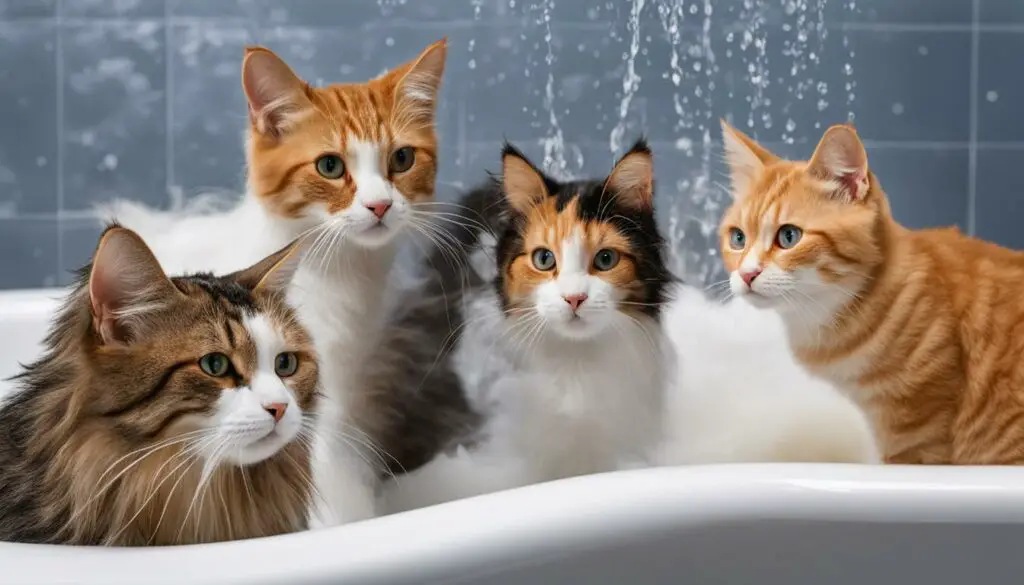
Grooming Routine
It’s important to keep in mind that bathing should not replace a regular grooming routine. Cats are naturally fastidious groomers and spend a significant amount of time cleaning themselves. Regular brushing helps remove loose hair, distribute natural oils, and stimulate blood circulation, promoting a healthy coat and skin.
If your cat is not receptive to baths or has a particular aversion to water, there are alternatives to consider. Waterless shampoos and wipes can be used for quick cleanups and spot cleaning. These products are formulated to be safe for cats and can help freshen up their coat without the need for a full bath.
| Bathing Cats: Pros | Bathing Cats: Cons |
|---|---|
|
|
Types of Cat Shampoo
When it comes to choosing the right shampoo for your cat, there are several types available to suit different needs. Understanding the options can help you make an informed decision and provide the best care for your feline friend.
Generic Cat Shampoos
Generic cat shampoos are the most common type and are suitable for regular grooming and basic cleaning. These shampoos are formulated to gently cleanse the cat’s coat and skin without causing irritation. They are often fragrance-free and designed to maintain the natural balance of the cat’s skin.
Medicinal Cat Shampoos
If your cat has specific skin issues or conditions, medicinal cat shampoos can help address these concerns. These shampoos are formulated with ingredients that target specific problems such as dryness, allergies, or fungal infections. It is important to consult with a veterinarian to determine the appropriate medicinal shampoo for your cat’s specific needs.
Waterless Cat Shampoos
Waterless cat shampoos are a convenient option for cats that dislike water or for situations where bathing is not possible. These shampoos come in the form of sprays or powders and are designed to clean and freshen the cat’s coat without the need for rinsing. They are typically applied and then brushed through the fur, removing dirt and oils.
Wipes
Cat wipes are another alternative to traditional shampoos and are useful for quick cleanups or spot treatments. These wipes are pre-moistened with gentle cleaning solution and can be used to freshen the cat’s coat, remove dirt, and reduce odors. They are particularly handy for cats that are difficult to bathe or for maintaining hygiene between baths.
In conclusion, choosing the right cat shampoo involves considering your cat’s specific needs and preferences. Whether you opt for a generic shampoo, a medicinal formula, a waterless option, or wipes, regular grooming and proper hygiene play a vital role in keeping your cat’s skin and coat healthy and dandruff-free.
The Best Cat Shampoos: Regular Shampoo
| Product | Description |
|---|---|
| TropiClean Deep Cleansing Shampoo | A recommended cat shampoo that moisturizes and conditions the cat’s skin and coat. It has a sweet and fruity scent and is soap-free, making it safe for cats. This shampoo is suitable for cats 12 weeks and older. |
When it comes to finding the best cat shampoo for your furry friend, TropiClean Deep Cleansing Shampoo is a top recommendation. This shampoo not only effectively cleanses your cat’s skin and coat but also provides the necessary moisture and conditioning to help combat dandruff. With its soap-free formula, you can have peace of mind knowing that it is safe for your cat’s delicate skin.
One of the standout features of TropiClean Deep Cleansing Shampoo is its delightful sweet and fruity scent. This adds an extra touch of freshness to your cat’s grooming routine, leaving them smelling clean and pleasant. Additionally, the soap-free formulation ensures that it won’t strip away the natural oils from your cat’s coat, helping to maintain its healthy shine.
Whether your cat has dandruff or simply needs a regular cleaning, TropiClean Deep Cleansing Shampoo is a reliable choice. Suitable for cats 12 weeks and older, this shampoo provides a gentle and effective cleansing experience that your cat will appreciate.
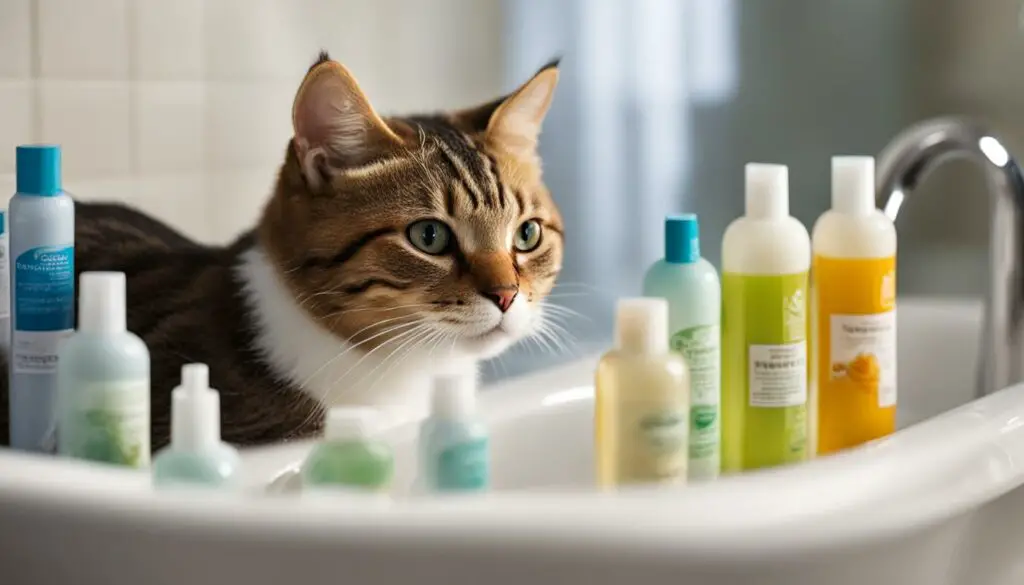
Summary:
TropiClean Deep Cleansing Shampoo is a recommended cat shampoo for managing dandruff. With its moisturizing properties and sweet and fruity scent, it not only cleanses but also conditions your cat’s skin and coat. The soap-free formula ensures a gentle and safe grooming experience. Suitable for cats 12 weeks and older, this shampoo is a reliable choice for maintaining your cat’s skin health and reducing dandruff.
The Best Cat Shampoos: Waterless Shampoo
When it comes to grooming your cat, not all cats are fans of water. That’s where waterless shampoos come in handy. A popular choice among pet owners is the Wahl Pet Friendly Waterless No Rinse Shampoo. This waterless shampoo offers a convenient and stress-free way to keep your cat’s coat clean and fresh without the need for water.
One of the standout features of the Wahl Pet Friendly Waterless No Rinse Shampoo is its delightful lavender and chamomile scent. This soothing fragrance not only helps to eliminate odors but also provides a calming effect for your furry friend during the grooming process.
Designed with your cat’s safety in mind, this waterless shampoo is formulated to be safe for daily use. Simply spray the shampoo onto your cat’s coat, massage it in gently, and then towel dry. It’s a quick and easy solution for keeping your cat looking and smelling their best.
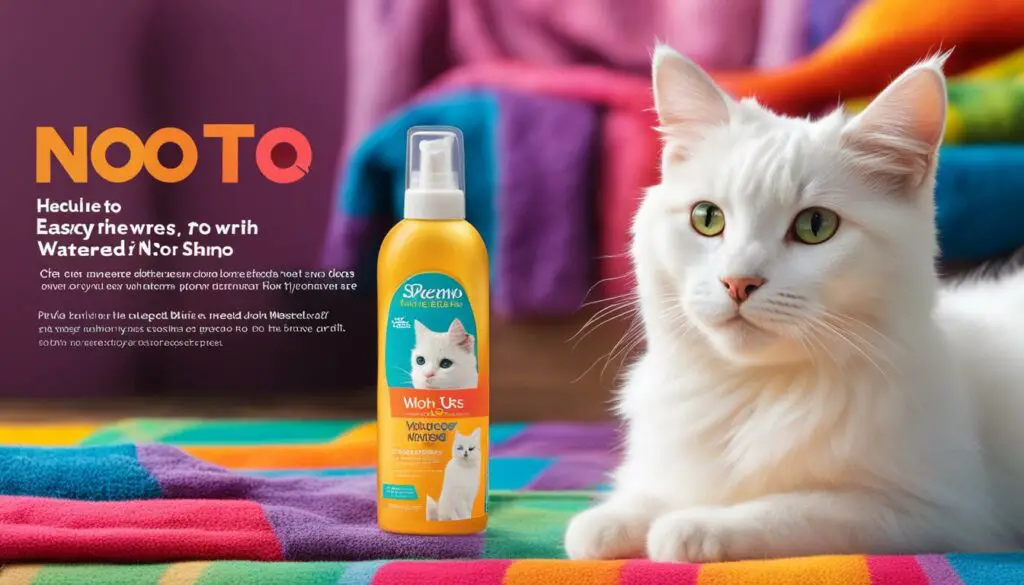
Table: Comparison of Waterless Cat Shampoos
| Waterless Shampoo | Key Features | Recommended Use |
|---|---|---|
| Wahl Pet Friendly Waterless No Rinse Shampoo | Lavender and chamomile scent, safe for daily use | Regular grooming and quick cleanups |
| Example Shampoo 2 | Description of key features | Recommended use and purpose |
| Example Shampoo 3 | Description of key features | Recommended use and purpose |
When it comes to keeping your cat clean and fresh, the Wahl Pet Friendly Waterless No Rinse Shampoo is a top choice. With its lovely scent, safe formula, and easy application, it’s a great option for cat owners looking for a waterless grooming solution.
The Best Cat Shampoos: Shampoos for Specific Needs & Medicinal Shampoos
When it comes to addressing specific needs and treating various conditions, there are several cat shampoos available that offer effective results. These shampoos are formulated to target specific issues and provide the necessary care for your cat’s skin and coat. Whether you’re dealing with bacterial or fungal infections, flea and tick infestations, or dry and irritated skin, there is a shampoo designed to meet your cat’s specific needs.
Veterinary Formula Clinical Care Antiseptic and Antifungal Shampoo: This shampoo is specially formulated to treat bacterial and fungal infections on your cat’s skin. It helps relieve itching, scaling, and redness, and is gentle enough to use regularly. It contains benzethonium chloride and ketoconazole to effectively eliminate the underlying causes of skin infections.
Adams Plus Flea & Tick Shampoo: If your cat is dealing with pesky fleas and ticks, this shampoo is a great choice. It not only kills fleas, ticks, and lice on contact, but also provides long-lasting protection against reinfestation. It contains natural ingredients like pyrethrins and piperonyl butoxide to effectively eliminate these parasites without harming your cat.
Organic 5 in 1 Oatmeal Shampoo & Conditioner: For cats with dry and irritated skin, this shampoo and conditioner combination is a soothing and nourishing option. It contains organic oatmeal, coconut oil, aloe vera, and chamomile extract to moisturize and calm the skin, reducing itchiness and promoting healthy fur. It also helps restore the natural pH balance of your cat’s skin.
| Shampoo | Main Benefits | Key Ingredients |
|---|---|---|
| Veterinary Formula Clinical Care Antiseptic and Antifungal Shampoo | Treats bacterial and fungal infections | Benzethonium chloride, ketoconazole |
| Adams Plus Flea & Tick Shampoo | Kills and prevents fleas, ticks, and lice | Pyrethrins, piperonyl butoxide |
| Organic 5 in 1 Oatmeal Shampoo & Conditioner | Soothes and moisturizes dry and irritated skin | Organic oatmeal, coconut oil, aloe vera, chamomile extract |
Conclusion
In conclusion, managing cat dandruff requires a holistic approach that encompasses grooming, adjusting the environment, maintaining a healthy diet and hydration, and choosing the appropriate shampoo. Regular brushing and bathing with cat-safe shampoo are essential for removing dandruff and promoting healthy skin. Additionally, using moisturizers specifically formulated for cats can help alleviate dryness and itchiness.
Adjusting the environment by adding a humidifier and using air purifiers can combat dry indoor air and reduce allergens that may irritate your cat’s skin. Providing a diet rich in skin-healthy vitamins and minerals, opting for high moisture content food, and supplementing with omega-3 fatty acids can improve your cat’s overall skin health.
When choosing a shampoo, it’s important to consider your cat’s specific needs. Whether you opt for a regular shampoo, a waterless option, or a medicinal shampoo for specific conditions, make sure it is safe for cats and addresses your cat’s specific issues.
By following these strategies and consulting with a veterinarian when necessary, you can effectively manage and prevent cat dandruff, ensuring your feline companion’s skin health and overall well-being.
FAQ
What are the symptoms of cat dandruff?
The most common symptoms of cat dandruff include red, dry, flaky, and itchy skin. These symptoms can occur on various parts of the cat’s body, such as the face, back, tail, and other areas.
What causes dandruff in cats?
Dandruff in cats can be caused by various factors, including inadequate grooming, poor nutrition, and underlying health issues. Some common causes of dandruff in cats include contact dermatitis, diabetes, hyperthyroidism, fungal infections, parasites, seborrhea, and food allergies.
When should I visit a veterinarian for my cat’s dandruff?
It is important to visit a veterinarian if your cat shows any additional symptoms in conjunction with their dandruff or if the dandruff is sudden and severe. Symptoms to look out for include appetite changes, excessive itching or grooming, excessive thirst, lethargy, litter box issues, skin lesions, visible parasites, and vomiting.
What are some solutions for managing cat dandruff?
Managing cat dandruff involves adjusting the environment to ensure proper humidity levels, managing the underlying condition if present, regular bathing and brushing, changing the cat’s diet if food allergies are suspected, using a moisturizer specifically formulated for cats, and using a humidifier to add moisture to the air.
How can I improve my cat’s skin care?
Regular brushing is an important part of skin care for cats. It helps distribute natural oils to the coat, making it supple and shiny. Additionally, brushing stimulates the cat’s circulatory system, improving the health of the skin and fur.
What options do I have for grooming my cat?
Grooming is an essential part of managing cat dandruff. This can include regular bathing, additional brushings, and using self-grooming cat products. It is important to use a cat-safe shampoo when bathing your cat and to avoid using human shampoo. Wipes and waterless shampoos can also be used as alternative grooming solutions.
How can I improve the environment for my cat?
Adjusting the environment can help improve your cat’s dandruff condition. This can include adding a humidifier to combat dry indoor air, using air purifiers to filter allergens that may be irritating your cat’s skin, and managing other environmental factors that may contribute to dry skin.
How can I maintain my cat’s overall health, diet, and hydration?
Maintaining your cat’s overall health, diet, and hydration is important in managing dandruff. Ensuring that your cat’s food contains skin-healthy vitamins and minerals, opting for high moisture content food, and supplementing their diet with omega-3 fatty acids can help improve their skin health. Additionally, cat wellness plans can be tailored to your cat’s individual needs.
Why is it important to manage cat dandruff?
Dandruff in cats should not be ignored. It can lead to itching, inflammation, and potential infections. Preventing and managing dandruff involves addressing underlying conditions, regular grooming, adjusting the environment, and providing proper care and nutrition for your cat.
Do cats need baths?
Cats are clean animals and groom themselves regularly. However, there are instances where bathing your cat may be necessary, such as to remove unwanted smells, improve appearance, or prevent the spread of dirt and fur around the house. Allergy sufferers may also find bathing their cat temporarily eases symptoms.
What types of cat shampoos are available?
There are different types of cat shampoos available, including generic cat shampoos, medicinal cat shampoos for specific conditions, waterless cat shampoos that don’t require water, and wipes that can be used for quick cleanups. Each type has its own benefits and specific uses for different situations.
What are some recommended cat shampoos?
The TropiClean Deep Cleansing Shampoo is a recommended cat shampoo that moisturizes and conditions the cat’s skin and coat. The Wahl Pet Friendly Waterless No Rinse Shampoo is a waterless option for cats. There are also cat shampoos available for specific needs and medicinal purposes, such as the Veterinary Formula Clinical Care Antiseptic and Antifungal Shampoo, the Adams Plus Flea & Tick Shampoo, and the Organic 5 in 1 Oatmeal Shampoo & Conditioner.
What is the key to managing cat dandruff?
Managing cat dandruff involves a combination of grooming, adjusting the environment, maintaining a healthy diet and hydration, and choosing the appropriate shampoo. Regular brushing, bathing with cat-safe shampoo, and using moisturizers can help improve the health of the cat’s skin and reduce dandruff.

